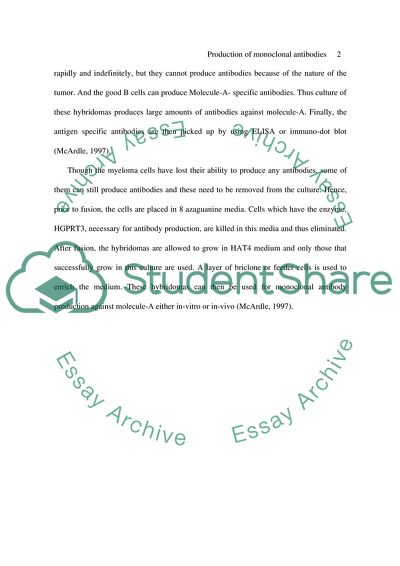Cite this document
(Production of Monoclonal Antibodies Coursework Example | Topics and Well Written Essays - 1500 words, n.d.)
Production of Monoclonal Antibodies Coursework Example | Topics and Well Written Essays - 1500 words. https://studentshare.org/health-sciences-medicine/1736705-describe-how-you-would-make-a-monoclonal-antibody-against-this-molecule-discuss-how-the-mab-would-be-adapted-for-use-as-a-diagnostic-tool-and-for-use-as-a-therapeutic-mab-in-a-human-trial-compare-to-real-examples
Production of Monoclonal Antibodies Coursework Example | Topics and Well Written Essays - 1500 words. https://studentshare.org/health-sciences-medicine/1736705-describe-how-you-would-make-a-monoclonal-antibody-against-this-molecule-discuss-how-the-mab-would-be-adapted-for-use-as-a-diagnostic-tool-and-for-use-as-a-therapeutic-mab-in-a-human-trial-compare-to-real-examples
(Production of Monoclonal Antibodies Coursework Example | Topics and Well Written Essays - 1500 Words)
Production of Monoclonal Antibodies Coursework Example | Topics and Well Written Essays - 1500 Words. https://studentshare.org/health-sciences-medicine/1736705-describe-how-you-would-make-a-monoclonal-antibody-against-this-molecule-discuss-how-the-mab-would-be-adapted-for-use-as-a-diagnostic-tool-and-for-use-as-a-therapeutic-mab-in-a-human-trial-compare-to-real-examples.
Production of Monoclonal Antibodies Coursework Example | Topics and Well Written Essays - 1500 Words. https://studentshare.org/health-sciences-medicine/1736705-describe-how-you-would-make-a-monoclonal-antibody-against-this-molecule-discuss-how-the-mab-would-be-adapted-for-use-as-a-diagnostic-tool-and-for-use-as-a-therapeutic-mab-in-a-human-trial-compare-to-real-examples.
“Production of Monoclonal Antibodies Coursework Example | Topics and Well Written Essays - 1500 Words”. https://studentshare.org/health-sciences-medicine/1736705-describe-how-you-would-make-a-monoclonal-antibody-against-this-molecule-discuss-how-the-mab-would-be-adapted-for-use-as-a-diagnostic-tool-and-for-use-as-a-therapeutic-mab-in-a-human-trial-compare-to-real-examples.


